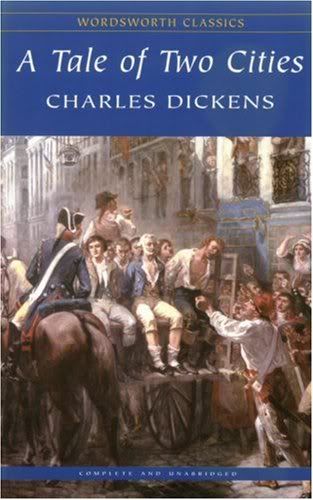More serious, more tense, less comical, Dicken's 'A Tale of Two Cities' is a uniquely different novel compared to the rest of his oeuvre. Dickens claimed it to be the 'best story I have written.' It is certainly tighter, more succinct in nature; however characters are not quite as engaging as in his other works. Despite this, 'A Tale of Two Cities' is a rich evocation of the turbulent end of the 18th century with Paris in turmoil to revolution and London buckling under crime and poverty.
The beginning of the novel is grand and, of course, instantly memorable: 'It was the best of times, it was the worst of times, it was the age of foolishness, it was the epoch of belief...' Dickens prepares us for the historical setting like a Shakespearean statesman: 'Friends, Romans, Countrymen...' Unlike many of his other novels, the grand themes of a previous age are announced as if from a pulpit. And with an opening scene pertaining to a carriage driving through fog, there is an atmosphere of stately moroseness. Dicken's effortless rendering of atmosphere is what gripped me the most; the sense of mystery and suspense the initial hook. Dicken's descriptions of London and particularly Paris through its bloodthirsty revolution are highlights. He researched ardently, and at the time he had come out of his marriage depressed and sombre. It shows. This is a Dickens looking upon the past with less humour, more wisdom.
At times I was frustrated by Dicken's masking of characters, his sometimes slow revealing of character's intentions and desires. In some ways this perhaps merely reflects the times, especially in Paris where so many were ambiguous personalities; spies, suspicious of the aristocracy. The expanded metaphor of Mrs Defarge knitting the plots of revolution is also symbolic of the story; it knits many characters together, across the English Channel. As I have said, in points I found this a little slow, but the reward is the finale, which took me by surprise. I expected a grand, revolutionary, chaotic ending, to parallel the stately opening. Instead the ending focuses on the sacrifice of one person for love. Dickens is, at the end, preaching less from the pulpit and more from the confession box. And this is what Dickens does best; showing the human condition in times of intense vulnerability. For me, the ending knitted everything perfectly or rather slashed the thread with a sharp edge.
I enjoyed 'A Tale of Two Cities' less than his other works, yet it remains just as memorable. It marks a turning point in his writing; one that is darker, less hopeful, more bleak.

No comments:
Post a Comment